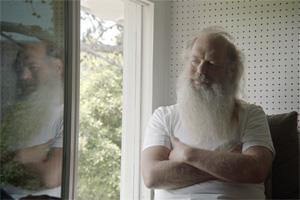
Some creative geniuses should not be asked to explain how they do it.
Shangri-La, a four-part documentary that debuts at 9 p.m. ET Friday on Showtime, adds Rick Rubin to that list.
From the way Rubin talks, he may agree.
That doesn’t make Shangri-La uninteresting, because happily, Rubin isn’t the only one talking. Once Chuck D of Public Enemy arrives on camera, the conversation starts to become something we can understand.
 And want to understand.
And want to understand.
Rubin (right) remains best known today for founding Def Jam Records while he was still a student at NYU. He eventually partnered with Russell Simmons, and between them, they turned Def Jam into the label where rap music busted loose and started its inexorable march to domination of popular music.
Rubin helped produce the likes of Run-DMC, LL Cool J, and Public Enemy, and that alone constitutes a resume the average music producer would be happy to sit on.
Not Rubin. He makes it clear, particularly in a conversation with LL, that way too many creative people let themselves get stuck repeating what was successful the first time and therefore never explore and grow.
No one’s going to say that about Rubin. He split from Def Jam more than 30 years ago, and since then has produced a battalion of artists that includes Tom Petty, Black Sabbath, Adele, and Johnny Cash.
The Cash sessions, while not particularly featured here, are widely considered defining for both Rubin and Cash. At a point in life when many artists are in demand only to play their hits, Cash recorded multiple albums of songs that he and Rubin just felt needed to be sung. It was a nice bonus that they turned out to be mildly commercial and critically acclaimed as well.
Rubin talks about looking for that kind of freedom in music everywhere, saying he’s drawn to artists who don’t seem to care what the rest of the music world sounds like at the moment. That’s admirable and helps explain how he’s been successful with such a diverse roster.
 This explanation only requires a couple of minutes, though. So in addition to footage of some Rubin artists at work, Shangri-La also has Rubin delivering long riffs about how, for example, his dream project would be one in which he never physically met the artist.
This explanation only requires a couple of minutes, though. So in addition to footage of some Rubin artists at work, Shangri-La also has Rubin delivering long riffs about how, for example, his dream project would be one in which he never physically met the artist.
He talks a lot about the ethereal side of music, the magic of its powers, and while no one would argue with any of it, after a certain point, he starts to sound like one more California cultural guru.
No disrespect intended, but take a number.
Rubin some years ago relocated from his native New York to Malibu. As several artists point out, this reflects the level of reward Rubin himself has earned from his mystic ears. Oh yes, and his shrewd promotion sense. He instructed the Beastie Boys, another of his Def Jam acts, to promote themselves by sounding like the strutting bad guys of professional wrestling.
A lot of people didn’t get that it was all an act, Rubin allows. And so what? It worked.
Bearded up like ZZ Top, Rubin comes across as a genial throwback to the hippie days of the ‘60s. The walls of the physical Shangri-La, which is his house/studio, have no pictures or other decorations because he doesn’t want artists to be distracted by anything when they’re creating.
In the end, Shangri-La does provide a more detailed, albeit still sketchy, portrait of a music producer whose influence over the past three decades cannot be overstated.
When Rick Rubin started putting together music for his friends in his NYU dorm room, hip-hop was widely viewed as an armed revolution taking direct aim at the safety, morality, and basic decency of the American living room. Today, hip-hop beats have been integrated into kindergarten rhymes.
Rick Rubin had a lot to do with that. By the end of Shangri-La, we may know almost as much as Rubin about how that happened.